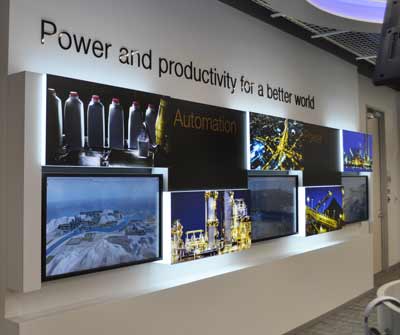A Digital Display is the Ideal Way to Deliver Information
Digital displays perform better than all other display mediums in terms of capturing attention, delivering memorable information and enhancing productivity. According to a study funded and published by the Intel Corporation, digital displays are 400 percent more likely to attract someone’s attention than static display options. That same study also determined that digital displays are excellent at making a memorable impact, as their recall rate is above 80 percent. That’s far beyond what static displays can offer.
Digital displays are proven advertising tools, but they aren’t limited to advertising. Digital displays are also productivity drivers in a corporate setting, where they can organize meeting rooms, enhance collaborative efforts, spotlight company or employee achievements, and deliver critical information to the people that need it right away.
Digital Displays in the Conference Room
Video conferencing solutions rely on digital displays to provide the video output, so they can be found in huddle rooms, conference rooms and boardrooms of all sizes. In these settings, digital displays can be used to bring people and entire teams together for a face to face conversation. Advanced
video conferencing solutions, like the Poly (Formerly Polycom) RealPresence Group Series, can turn one or more digital displays into a video conferencing focal point, a screen sharing device or a powerful meeting enhancer.
Digital signage, delivered using a digital display, also makes sense in a corporate setting. Digital signage can be used to direct people to a particular meeting room, present the schedule and availability of a particular meeting room, or keep people informed of company events or schedules. When leveraged in this fashion, digital displays reduce conflict among employees vying for meeting spaces and hold people accountable for the meetings they are scheduled for.
A digital display can prioritize information for particular departments, too, ensuring a unified team. For example, digital displays can keep a running inventory of parts, so assembly teams know what resources they have on hand, and the ordering department can respond faster. Management can also establish goals for departments or the entire company, and ensure these goals are clearly defined to relevant departments. If used creatively and positively, this can be a powerful motivator.
Interactive digital displays add valuable functionality to the mix. A small interactive display can be used to book a room without having to enter it and disturb a meeting in progress. The display can also be used to lock the room once it is in use, or engage the room’s other controls. Large interactive displays, like the Clevertouch, are collaboration dynamos, allowing teams to brainstorm visually and pull resources from the internet, or annotate over provided examples.
Digital Displays in Advertising
Digital displays are valuable advertising tools, and beat out static displays in every way imaginable. Here are just a few examples:
- Rapidly deployable advertising – Static displays are soon outdated and must be switched out constantly to maintain impact. Advertisements are designed remotely for digital displays, and then deployed to one, some or all of the company’s displays. With a single button press, the company’s entire digital signage can be changed out without anyone having to touch the display.
- Attract foot traffic – This goes back to the attention-capturing power of digital displays. According to a Fedex consumer study, eight out of 10 people have entered a business because of their signage. As digital displays are 400 percent more likely to grab a person’s attention, they convert more people into traffic for the business.
- Deliver relevant messaging – Static displays are the same for everyone. Digital displays can be configured to respond to particular demographics. For instance, new digital signage technology can accurately estimate a person’s age and gender, and can respond with different advertising depending on who is near the display. Advertising works best when it delivers a message tailored to the observer. Digital displays make that possible.
- Provide timely messaging – Businesses can change up their advertising efforts during certain times of the day, or certain days of the year. A restaurant may use its signage to announce happy hour times, with the displays switching to time-based messaging automatically. Holidays, festivals, sporting events and community events are all considerations for time-based messaging efforts, and only digital displays allow for it.
- Encourages interactivity – Digital displays can provide opportunities for customers to explore products, drop a review or testimonial, or just keep people entertained. Digital signage loaded with social media apps, for example, encourage customers to upload pictures and positive messages about the brand and its products. According to research published on Inc., 84 percent of consumers trust online reviews as much as a recommendation from a friend. Put that trust-building power to work with digital signage, where businesses can control the message.
- Provides immediate feedback – Digital advertising is a valuable research tool as it is rapidly deployable and effective at getting attention. Companies can roll out an advertising initiative with digital displays and make immediate changes if it doesn’t succeed right away. With time and use of digital signage, businesses can fine tune their messaging to make it as effective as possible.
No other display or form of signage can provide the engagement, the functionality, the versatility and ROI that a digital display can. With so many advantages over static displays, it’s easy to see why so many businesses are turning to digital displays and signage for a variety of uses.



